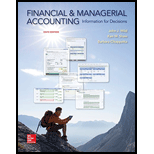
Concept explainers
(1)
To compute: Direct Labor Rate, Efficiency and Total Direct Labor Cost variance
(1)
Explanation of Solution
Direct Labor Rate
Formula to calculate Direct Labor Rate Variance,
Direct Labor Rate Variance for October
Substitute $15 for standard rate, $15.2 for actual rate. and 16,250 for actual hours.
Direct Labor Rate Variance for November
Substitute $15 for standard rate, $15.25 for actual rate. and 22,000 for actual hours.
Direct Labor Efficiency Variance
Formula to calculate Direct Labor Efficiency Variance,
Direct Labor Efficiency Variance for October
Substitute 16,800 for standard hour, 16,250 for actual hour. and $15 for standard rate per hour.
Direct Labor Efficiency Variance for November
Substitute 18,000 for standard hour, 22,000 for actual hour. and $15 for standard rate per hour.
Direct Labor Cost Variance
Formula to calculate Direct Labor Cost Variance,
Direct Labor Cost Variance for October.
Substitute 16,250 for actual hour, 15.20 for actual rate, 16,800 for standard hour. and $15 for standard rate per hour.
Direct Labor Cost Variance for November
Substitute 22,000 for actual hour, 15.25 for actual rate, 18,000 for standard hour. and $15 for standard rate per hour.
Thus, Direct Labor Rate Variance for October is $3250 unfavorable and for November is $5,500 unfavorable. Direct Labor Efficiency Variance for October is $8,250 favorable. and for November is $60,000 unfavorable and Direct Labor Cost Variance for October is $5,000 favorable. and for November is $65,500 unfavorable
Working note:
Calculation of Actual labor rate per hour,
Calculation of standard direct labor hours,
(2)
To interpret: October direct labor variances.
(2)
Explanation of Solution
In the month of October,
Thus, there is a total benefit of $5000 to company in October.
Want to see more full solutions like this?
Chapter 21 Solutions
Financial and Managerial Accounting: Information for Decisions
- Help pleasearrow_forwardPlease provide problem with accounting questionarrow_forwardJuan Leon Martinez posted Apr 7, 2025 11:25 AM Subscribe Hello everyone, Esteban is not performing in a professional manner in this scene. In fact, he is showing extreme unprofessional manners and unethical work ethic. Under no circumstance should he be using a company's tools or assets for his own benefit. You can also see he is trying not to get caught by any upper management due to him doing these actions after hours of work. As a manager, a great change I would do differently to make sure Esteban is not using the company's assets for their own benefit, would be coachings and sit down conversations. A sit down conversation can have the employee get an idea on how bad his actions are towards the company. This disciplinary of a coaching would be a written down statement from both manager and employee stating that he or she understands the actions they have done, which could lead to suspension or possibly termination. These unethical actions could lead to a great deal of financial loss…arrow_forward

 AccountingAccountingISBN:9781337272094Author:WARREN, Carl S., Reeve, James M., Duchac, Jonathan E.Publisher:Cengage Learning,
AccountingAccountingISBN:9781337272094Author:WARREN, Carl S., Reeve, James M., Duchac, Jonathan E.Publisher:Cengage Learning, Accounting Information SystemsAccountingISBN:9781337619202Author:Hall, James A.Publisher:Cengage Learning,
Accounting Information SystemsAccountingISBN:9781337619202Author:Hall, James A.Publisher:Cengage Learning, Horngren's Cost Accounting: A Managerial Emphasis...AccountingISBN:9780134475585Author:Srikant M. Datar, Madhav V. RajanPublisher:PEARSON
Horngren's Cost Accounting: A Managerial Emphasis...AccountingISBN:9780134475585Author:Srikant M. Datar, Madhav V. RajanPublisher:PEARSON Intermediate AccountingAccountingISBN:9781259722660Author:J. David Spiceland, Mark W. Nelson, Wayne M ThomasPublisher:McGraw-Hill Education
Intermediate AccountingAccountingISBN:9781259722660Author:J. David Spiceland, Mark W. Nelson, Wayne M ThomasPublisher:McGraw-Hill Education Financial and Managerial AccountingAccountingISBN:9781259726705Author:John J Wild, Ken W. Shaw, Barbara Chiappetta Fundamental Accounting PrinciplesPublisher:McGraw-Hill Education
Financial and Managerial AccountingAccountingISBN:9781259726705Author:John J Wild, Ken W. Shaw, Barbara Chiappetta Fundamental Accounting PrinciplesPublisher:McGraw-Hill Education





